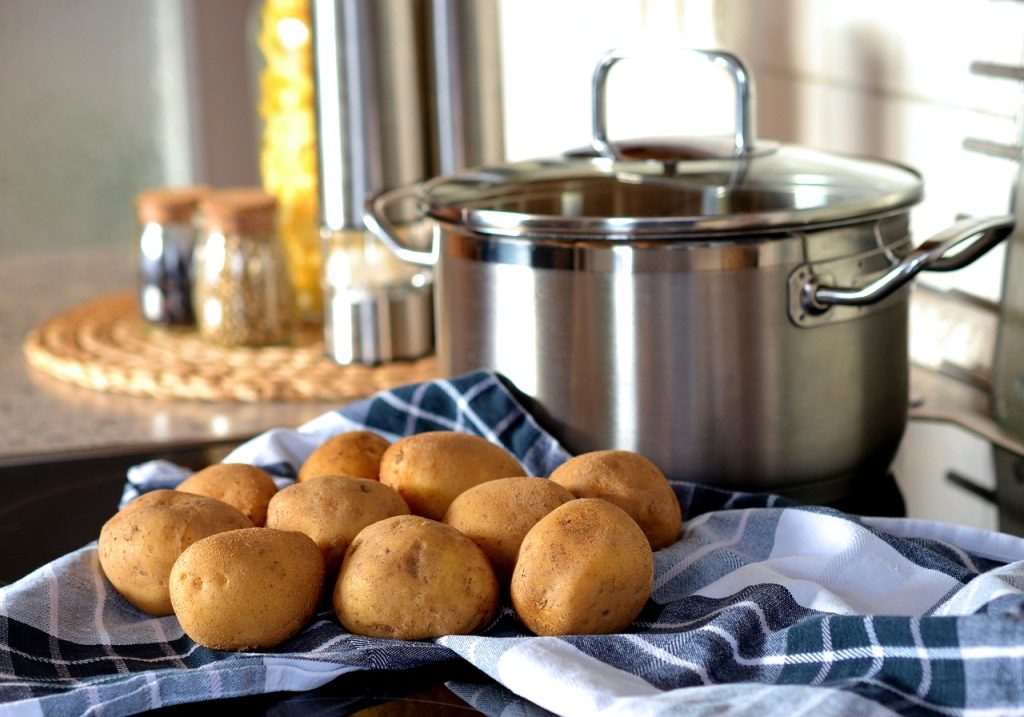
Does potato starch affect your gout? Read on to discover the potential risks of using potato starch in your cooking and baking, and how it may affect your risk of repeat gout flare-ups. We’ll also consider the ramifications of potato starch in processed foods and snacks on your gout.
Potato Starch and Gout
For clarity, I’m looking at potato starch in this article, not potato flour — they are two different things. And only as the extracted starch used in cooking and baking, not as exists naturally in cooked potatoes, which I cover here: Are Potatoes OK with Gout?
What is Potato Starch?
Potato starch, as used in cooking, is a fine white powder extracted from potatoes, some of which varieties are cultivated just for starch production.
The starch is made by grinding raw potatoes into a paste and then separating the starch granules through a process called “wet milling”.
Potato starch is used in a variety of applications, including:
- as a thickening agent in cooking .
- as a stabilizer in processed foods.
- as a fried food coating.
Potato starch is often used as a thickening agent for sauces, soups, and gravies, as it has a neutral flavor and doesn’t affect the color of the finished dish.
It’s also used as a binding agent in certain recipes, such as gluten-free breads and pastries, making it a popular choice for people with gluten sensitivities.
Starches are Complex Carbs
Technically speaking, starches are complex carbohydrates consisting of two components (polymers), amylopectin and amylose, which store the glucose plants need to thrive.
Potato starch has around 85% amylopectin and 15% amylose by weight, which relative values vary according to the type of potato used.
Amylopectin is more easily digested in our bodies than amylose, largely due to its more complex, multi-branched chemical structure. Amylose has a simpler, more linear, structure that makes it resistant to digestion, which is why it’s known as a resistant starch.
So, instead of being digested in the small intestine, amylose acts in a similar way to dietary fiber by moving through into the large bowel (colon) where it’s fermented and, acting as a prebiotic, helps to feed friendly gut bacteria, which supports immune function and helps to control inflammation.
However, many starches, including most potato starches, have a high glycemic index (GI) which can cause blood sugar levels to rise sharply and increase the risk of some conditions, such as type-2 diabetes, when consumed to excess.
What is Gout?
Gout is a form of arthritis caused by abnormally high uric acid levels in the blood, a condition called “hyperuricemia”.
Uric acid is a byproduct of the breakdown of purines: natural compounds found in our body’s cells and in our foods at varying concentrations.
When there’s an excess of purines in the diet, it can lead to an excess of uric acid in the blood. And when there’s too much uric acid in the blood, microscopic crystals can appear in the joints, leading to inflammation and pain: a gout flare (attack).
Gout Symptoms
The most common symptom of gout is a sudden, severe attack of pain, swelling, redness, and warmth in a joint. Other symptoms include fever, chills, fatigue, and difficulty moving the affected joint.
Gout attacks can be unpredictable and can occur at any time, often at night, and most often in the big toe. However, gout can also affect other joints, such as the knees, ankles, wrists, and fingers.
Who’s at Risk?
Gout is more common in men than women, although the risk for women increases after the menopause.
People who consume a diet high in purines, alcohol, and sugar (especially high-fructose corn syrup), are also at risk.
And being overweight or obese is recognized as a particular high risk factor for gout.
But it’s not just diet and lifestyle considerations, those with certain medical conditions, such as high blood pressure or kidney disease, are also at a higher risk of gout.
Treatment
While there’s no cure for gout, certain medications and some dietary & lifestyle changes can help gout patients manage their symptoms…
For example, the risk of gout flares may be reduced by moving to an overall low-purine diet that entails avoiding high-purine foods, such as organ meats and seafood, and limiting foods with moderate amounts of purine, like lean red meat, poultry, and certain types of seafood.
Low-purine foods, such as vegetables, fruit, eggs, low-fat dairy products (e.g., low-fat milk, cheese, and yogurt), nuts, seeds, and whole grains, are generally safe to eat.
Alcoholic drinks and sugary drinks should also be avoided or severely limited as both are associated with an increased risk of gout flare-ups.
And medications, such as nonsteroidal anti-inflammatories (NSAIDs), allopurinol, and febuxostat, can be effective for most gout patients: NSAIDs to reduce pain and inflammation and allopurinol or febuxostat to maintain serum uric acid at healthy levels.
So what about potato starch used for cooking and baking? Is it benign or problematic for gout sufferers?
Does Potato Starch Increase Uric Acid?
The good news is that potato starch is very low in purines and fructose, so these compounds don’t contribute that much, if at all, to overall uric acid load.
On the other hand, potato starch has a high glycemic index (GI) which can spike blood sugar and lead to weight gain and type-2 diabetes when consumed too frequently. Being overweight/obese is a high risk factor for gout and studies have reported a possible link between diabetes and gout.
However, we’re just considering potato starch as used in home cooking and baking here, not as in large servings of cooked potatoes or potato-based dishes. So the amount of starch being added as a thickener in a dish, for example, shouldn’t be a cause for concern as long as it isn’t taken to extremes.
Of more serious concern is potato starch, or any other starch for that matter, used in processed foods and snacks, since these are so very easy to consume to excess.
To make matters worse, many of these foods also contain high levels of salt and high fructose corn syrup. These aren’t just a risk to general health but also to your gout, which is why a healthy gout-friendly diet usually avoids or severely limits processed foods and snacks.
Summary
Potato starch is a complex carbohydrate used, among other things, as a thickening agent in cooking and as a binding agent in certain recipes, such as gluten-free breads and pastries.
Gout is a painful form of inflammatory arthritis caused by high uric acid levels in the blood, which uric acid is the end product of purine metabolism.
But although potato starch is low in purines and fructose (which can also raise uric acid levels), it does have a high glycemic index (GI) which can spike blood sugar, leading to weight gain and type-2 diabetes when overconsumed.
General health considerations aside, being overweight or obese is a known high risk factor for gout and, according to some studies, there may be a link between type-2 diabetes and gout, too.
In order to mitigate these risks, when used in the home environment, potato starch is best used in moderation.
But potato starch isn’t only used in home cooking and baking, it’s also widely used in commercially processed foods and snacks along with many other additives, including high fructose corn syrup, which is strong;y associated with increased uric acid levels.
So processed foods and snacks should be avoided or, at the very least, severely limited in order to reduce the risk of gout flare-ups.



